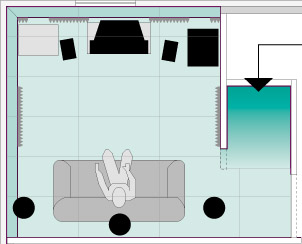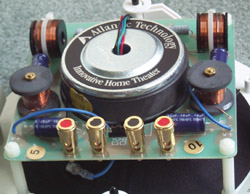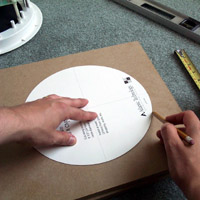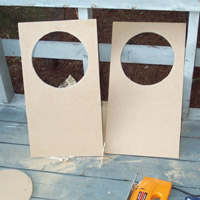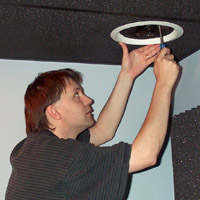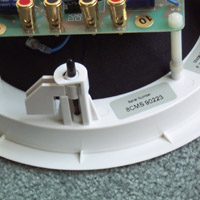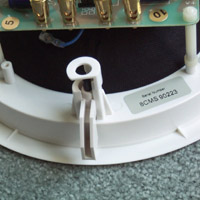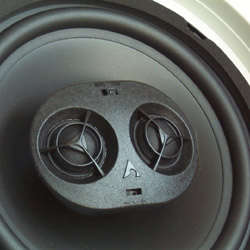|
||||||||||||||||||||||||||||||||||||||
|
Spatially Challenged Like so many others, my home theater was for many years part and parcel incorporated into the living room. My wife and I get along just fine, and we compromised well: She put up with those big ugly boxes (a.k.a. speakers), and I put up with country style wall paper. There were times though when I wanted to get away to a "movie-only zone" without being preoccupied with whether I'm disturbing anyone, or, more importantly, if anyone is disturbing me. Beyond that, I'm supposed to be an Associate Editor for a recognized web-zine. I of all people should have a dedicated room . . . right? Trouble was, we had no space, at least none that loaned itself to a home theater. There was plenty of real estate in the basement but none of it contiguous: A load bearing wall through the middle precluded the creation of a "normal" sized theater. In a fit of courage (or perhaps madness), I conceived a two-seater theater in an unfinished 10x11 space. The acoustically knowledgeable among you will already be making assumptions about the sound (as I did), but casual consultation with acquaintances, including one at THX, assured me it could work. A substantial opening at rear right, lots of absorption and diffusion in the right places, a notch filter on the subwoofer, and indeed the room sounds way better than our living room ever did. When it's 100% done, I'll do an article on how it all came together. I did get one warning though: "The rear surrounds are going to be tricky". The only way a pair of monopoles could be placed such that they did not shout, "Hey, over here!" was to place them on the floor, pointed at the ceiling. Not a bad surround sound field but not a practical solution (the cat kept wanting to park himself on one or the other during a movie). I've always advocated dipole surrounds, but the textbook correct placement would put the right surround speaker somewhere in mid-air, precisely where we walk in. Then a press release came across my virtual desk: In-Ceiling Di-Pole speakers from Atlantic Technology. Since you almost never see reviews of in-wall speakers for obvious reasons, I decided to offer up my ceiling to you our readers and give these a try.
The IWTS-8 The IWTS-8 is the larger of two models specifically designed for ceiling installations. Its 4-1/2" depth requirement actually makes in-wall installation in normal 2x4 construction impossible without some serious fudging. When fellow Secrets staff member Sandy Bird came over to check them out, his first reaction was, "Oh, you've used car speakers". He was half serious I think. While I'm told a pair of coaxially mounted tweeters over a woofer is a common configuration in the car audio world, the IWTS-8 has nothing in common with a car speaker. They are made entirely in the USA to Atlantic Technology's spec and are not an adaptation of an existing design or product. The IWTS-8, through a set of jumpers and switches, can be configured to operate in one of three modes: Tri-Vector. The two tweeters are out of phase with each other (the two domes move in the opposite direction at the same time). Note that this is mode is not called dipole since it only operates as such above 2kHz. Monopole. The two tweeters are in phase with each other (the two domes move in the same direction at the same time). Stereo. The two tweeters get their own input, as do the separate voice coils in the woofer. Basically, think of it as two conventional speakers right next to each other. Reminds me of the prescribed arrangement for the rear speakers in a THX Ultra2 set-up. We'll talk about that later too.
There is also a treble adjustment switch on the tweeter baffle with three settings: flat, reduced, and boosted. The intention is to compensate for how far off-axis you are (the further off, the less treble you get). It is a very mild adjustment, 2 dB either way, which Atlantic Technology feels is appropriate for the purpose. We elected to try a pair, configured as TriVector, to the left and right of the seating area, placing them as far apart as possible, equidistant to the seats, without the right surround channel being out of the room. Our seating arrangement puts our heads right in line with one of the ceiling's main runners, so we plotted the surrounds' placement just back of that line. At 8 pounds+, these speakers are not exactly feather weight, and as such I did not feel comfortable asking the acoustical ceiling tiles to hold all that mass. Our solution was to make "mounts" out of 1/2" MDF board, cut to a length of 23-3/4" (the width of a ceiling tile), thereby spanning the distance between two main runners and thus putting all the weight on the grid. Using the supplied template, I traced the 9-1/2" circle onto the MDF, making sure it would place the speaker right where we wanted it, and cut the hole with a jigsaw. I placed the board on top of the ceiling tile, being careful to position it where I wanted the speaker, and then used a utility knife to cut the tile, letting the MDF's hole be my guide.
Atlantic Technology's mounting system consists of four fly-out "ears". Once the speaker is in place, you simply turn the screw on each one to lock it down. The clip will fly out where, when the screw it tightened, it will "clamp" the speaker to the ceiling.
I should note here for the record that officially you need, for safety reasons, some tie to the joists above the false ceiling grid. A simple wire, same as the ceiling itself is suspended with, secured to the speaker, will do. It was then just a matter of making the connections, and I was ready for calibration. The IWTS-8 uses spring-tensioned posts that accept bare wire and bananas. Spring loaded connections are actually a good idea for in-walls because once installed, there is no opportunity to cinch up a conventional binding post. A screw terminal would work fine, but that would preclude the use of pre-terminated wire like the Nordost stuff and its Z-plug banana that I ran through the walls and across the ceiling. By definition, in ceiling speakers are exposed to the possibility of stuff like dirt and debris falling into them. Atlantic Technology puts a cloth cover over the driver but still recommends you take action to further protect them. In our case, we laid a full size 4" insulation batting over each one. The grille comes lined on the inside with a thin white cloth-like material. It is acoustically transparent and only serves to mask the black appearance of the drivers. If painting to match decor, you will want to remove it and replace it afterward (or not at all if your color is a dark one).
In Practice "Getting the surrounds right is fun, and balancing the direct/reflected ratio for each room and individual speaker location can be fascinating since it often defies logic". These were words of wisdom from a man whose knowledge of this stuff I particularly appreciate. Even Atlantic Technology notes that ceiling placement like this is not ideal. They don't claim these speakers to be a panacea. With that in mind though, they have obviously done their homework, thought this through, and have come up with a speaker that does the best possible job when the project dictates ceiling surround placement. As far as their sound in the strict sense, I could find nothing wrong. No unusual aberrations or distortions. The bass goes down . . . way down. They had measurable output at 20 Hz in fact! Even though I rolled them off at 70 Hz, they still delivered a strong (but clean) bass presence. As sounds pan between the speakers, the sonic effect was absolutely delicious. The back wall of the room seemed to disappear, or at least gets psycho-acoustically pushed back several feet. The seam with the front soundstage was somewhat less synergistic, but I believe that is an acoustic consideration of where they were in the room. Overall, the sound is exactly what is heard from the surround arrays at Empire Theaters Regent Mall, Cinema #1 (Dolby CP650 with EX card option). In other words, Atlantic Technology has somehow managed a decidedly spatial sound despite the fact that the woofer is firing right down and the tweeters are firing more down into the room as opposed to front and back. They do, in my configuration at least, come across as sounding a little "above" you but then again, so do the surrounds at Regent Mall #1. Again, I had Sandy come over for a second opinion, and after flipping through about a dozen DVDs, he made an interesting observation: In looking at the movie scene, EVERY surround sound "effect" is coincident with something that is implied visually to be above ear level, never at or below it. Considering that movie soundtracks are assembled in dubbing stages configured the same as cinemas (with the surrounds high on the walls), this all makes perfect sense. THX Ultra2 adds two new playback modes intended for 7.1 presentation of non-EX encoded 5.1 material. They accomplish this through their new ASA process (Advanced Speaker Array), applied to a pair of rear (a.k.a. center surround) speakers. The ideal placement of the pair for ASA is right next to each other. A single IWTS-8 configured for Stereo operation is absolutely perfect for the roll. In our situation, where were getting a bit of a hole behind us, the inclusion of the rear surrounds was a genuine boon. As a single quasi-stereo speaker, the IWTS-8 indeed satisfies. It would be nice to place one over a living room couch or centered over the dining room table for clear, articulate, but discreet mood music. With the previously mentioned robust bass performance, these speakers can genuinely deliver full bodied music. Conclusions In-wall speakers of any kind require a certain amount of faith. Faith that you'll get them in the right place, both esthetically and sonically, and faith that the manufacturer did their homework (since showrooms with functioning in-walls are rare, and magazine reviews are even rarer). Atlantic Technology has demonstrated a dedication to this vertical market which is matched by only a few. Being the first (and still one of the very few) to market with a THX in-wall setup (including in-wall subwoofer), they have distinguished themselves, showing they've got what it takes. If ceiling mounted surrounds is dictated by your lay-out, there is no question that something from the IWTS series should be a top consideration for you. Caveat: After MUCH listening, we made a fairly significant observation about the sound: The left channel sounded awesome, but the right did not. Specifically, the left surround had the spacious, omnipresent sound I desire and expect from a surround speaker. The right, despite being set correctly for dipole operation, came across as more point source. This has absolutely nothing to do with the speakers and everything to do with the acoustic space each one was in. It dawned on me that the left surround had a nice set of boundaries to reflect off of, most notably the left side wall, while the right was somewhat out there on its own (see the floor plan at the beginning of the review). It might also have been preferable to mount the center surround/rear unit on the back wall instead of the ceiling. The moral: When contemplating these or any other in-ceiling surrounds, placement is a prime consideration. In the surround role, surfaces for them to "wash" with sound are desirable, and distancing yourself a little bit from them is also a must for maximum diffuseness. - Brian
Florian -
|
||||||||||||||||||||||||||||||||||||||


